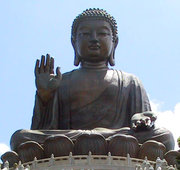Tian Tan Buddha
|
|
The Tian Tan Buddha (天壇大佛) is a large bronze statue of the Buddha, located at Ngong Ping, Lantau Island, in Hong Kong. Also known as the Giant Buddha, it is the world's tallest outdoor seated bronze Buddha. The statue is located near the Po Lin Monastery. It symbolizes the harmonious relationship between man and nature, people and religion. It is a major center of Buddhism in Hong Kong, and is also a popular sightseeing attraction.
| Contents |
Description
The statue is named "Tian Tan Buddha" because its base is a model of Tian Tan, the Temple of Heaven in Beijing. It is one of the five large Buddha statues in China. The Giant Buddha statue sits peacefully on a lotus throne on top of a three-platform altar. It is surrounded by eight smaller bronze statues representing gods or immortals.
The Buddha is 34 meters high and weighs 250 tons. This, the world's tallest Buddha, can even be seen as far away as Macau on a clear day. Visitors have to climb 268 steps in order to reach the Buddha.
The Tian Tan Buddha appears serene and dignified. His right hand is raised, representing the removal of affliction. His left hand lies on his knee, signifying human happiness. The Buddha faces north, which is unique among the great Buddha statues. (All others face South.)
In addition there are 3 floors at the bottom of Buddha: 'The Hall of Universe', 'The Hall of Benevolent Merit' and 'The Hall of Remembrance'. One of the most renowned features inside is a relic of Sakyamuni, consisting of some of his alleged cremated remains. There is a huge carved bell inscribed with images of Buddhas and lections in the show room. It was designed to ring every seven minutes, 108 time a day, symbolizing the release of 108 kinds of human vexations.
History
The Tian Tan Buddha was constructed beginning in 1990, and was finished on December 29, 1993, the birthday of Sakyamuni. The construction costs of the giant Buddha were estimated to be up to $68 million. It was formed out of 202 separate pieces of bronze. In addition to the exterior components, there is a strong steel framework inside the statue to support the heavy load and wind pressure.
When the statue was completed, monks from around the world were invited to the opening ceremony. Distinguished visitors from the People's Republic of China, Hong Kong, Taiwan, Japan, Thailand, Korea, Malaysia, Singapore, Sri Lanka, and the United States all took part in the proceedings.
On October 18, 1999 the Hong Kong Post Office issued a stamp depicting the Tian Tan Buddha. The MTR corporation has also issued a tourist souvenir ticket featuring a photograph of the statue.
Visitation and Tourism
This Buddha is one of the most popular sightseeing attractions in Hong Kong, and the Tian Tan Buddha has become ubiquitous on tourist schedules. The Monastery and the Buddha are open to public for visits between 10:00 and 17:45. Vegetarian meals are served in the monastery from 11:30 to 17:00. The entrance fee for the exhibition is HK$20 but the fee is waived for those purchasing a meal package. A card with Tian Tan Buddha printed on it will be given to visitors free of charge as a souvenir.
Image027.jpg
photograph of the Giant Buddha
Besides the exhibition, there are shops selling Buddha-related souvenirs like necklaces outside. There are also vegetable meals in the restaurants outside the Buddha.
Visitors can also go to visit the nearby Po Lin Monastery, the largest and one of the best known monasteries in Hong Kong. It is known as the "Buddhist Kingdom in the South," serving as an international Buddhist retreat.
Outside the grounds of the monastery, there are shops selling Buddha-related souvenirs like necklaces. There are also non-vegetarian meals in small restaurants.
Po Lin was built by three Zen masters in 1920. The main temples have painted vermilion interiors with dragons and many other different Chinese mythical figures on the walls and ceilings. Visitors often visit the attached tea garden, the only tea garden in the province. Also nearby is Lantau Peak, the second highest mountain in Hong Kong.
Buses travel from Tung Chung and Silvermine Bay Pier to Ngong Ping. The Buddha is located near the Hong Kong International Airport in Chek Lap Kok so it is very accessible. Visitors can reach Lantau Island by either a ferry from Pier No.6 in Central (the ferry goes to Silvermine Bay/Mui Wo) or MTR (stop at Tung Chung). Then take the following buses to get to the Monastary at Ngong Ping.
- From Mui Wo/Silvermine Bay take NLB No. 2 ↔ Po Lin
- From Tung Chung take NLB No. 23 ↔ Po Lin
Comparisons
Summary facts about other great Buddha statues are listed below.
Leshan Giant Buddha 樂山大佛
| Lingshan Buddha 靈山大佛 |
| Yungang Buddha 雲崗大佛 | Longmen Buddha 龍門大佛 |
Great Buddha of Kamakura
| Great Buddha of Nara
|
External Links
- About the Tian Tan Buddha (http://www.jobmaga.com.hk/advert/tian.htm)
- About the top 5 biggest Buddha statues in China (http://www.fushanan.per.sg/WanShanXF/WuFangDaFo.htm)
- Pictures of the Po Lin Monastery and the Tian Tan Buddha (http://www.photostock.com.hk/newterritories/polinmonestery1.htm)
- Hong Kong's official factsheet (PDF) (http://www.info.gov.hk/hkfacts_gb/crelig.pdf)

